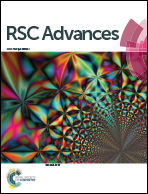High performance bipolar spin filtering and switching functions of poly-(terphenylene-butadiynylene) between zigzag graphene nanoribbon electrodes
Abstract
Using the nonequilibrium Green’s function method combined with spin-polarized density functional theory, we investigate the spin-resolved electronic transport properties of devices made of poly-(terphenylene-butadiynylene) (PTB) between two symmetric ferromagnetic zigzag graphene nanoribbon (ZGNR) electrodes. The bipolar spin filtering effect, rectifying behavior, and negative differential resistance have been found. More interestingly, an on/off ratio in the order of 107 is also predicted by changing the angle between the PTB and ZGNR electrode planes. Further analyses show that the matching of the electronic wave functions among both electrodes and PTB plays a key role in the multi-functional PTB based device. And the coupling between the alkyne triple bond and the phenyl rings of PTB is critical to the value of the spin-resolved current and the on/off ratio. These phenomena suggest that the proposed PTB based devices have potential utilization in molecular spin diodes and molecular switches.


 Please wait while we load your content...
Please wait while we load your content...